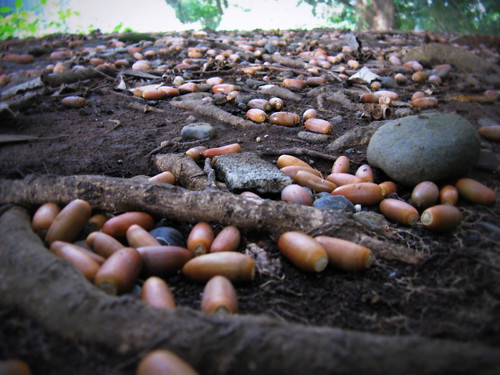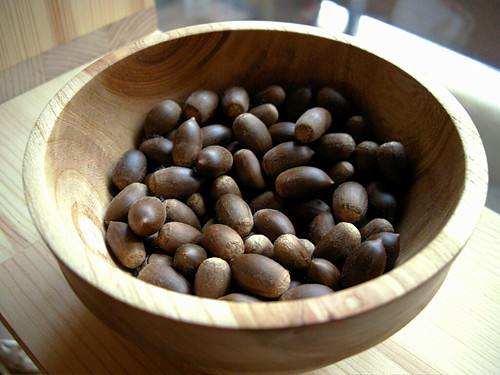November 22, 2011
Reconnecting Forests and People by Saving Acorns
Keywords: Newsletter
JFS Newsletter No.110 (October 2011)
Kagawa Prefecture in Shikoku, southwestern Japan, has been working for 19 years on an initiative to reconnect forests and people using acorns. The initiative is called the "Donguri Bank," where people "deposit" acorns ("donguri" in Japanese) just like money. Six months after depositing the acorns, they get seedlings back. As of 2010, over 20,000 people made deposits in the bank, and so far about 41,500 seedlings were returned to depositors. The acorns deposited to the bank are also "loaned" to public greenery businesses. This article explains this unique initiative and how it spread.
How the Bank Started
The Donguri Bank is not an ordinary bank in which people save money such as yen or dollars, but a bank in which they deposit acorns they gather in forests. On October 3, 1992, it was launched at a "Woody Festival," an event organized to help expand demand for wood products, held in Central Park, Takamatsu City, capital of Kagawa prefecture. In 1993, the initiative became a participatory afforestation program under the aegis of the prefecture.
The background to this initiative was the serious situation of local forests. Kagawa prefecture faces the Seto Inland Sea and has no big rivers; thus temperatures are high and little rain falls. For hundreds of years, the vegetation in satoyama forests (managed community forests near villages) in Kagawa consisted mainly of pine woods, including native drought-tolerant Japanese red pine and fast-growing Japanese black pine. However, since around 1975, weevil (pine wood nematode) damage has spread and most pine trees across the prefecture started to die off.
Moreover, some developers sold dying pine woods at very low price and also overexploited forest area as sand and rock quarries to produce high-quality pit sand. Some malicious businesses illegally dumped and buried industrial waste in land which had lost its topsoil and was full of holes. This land was then re-sold as farm or residential land.
Against this backdrop, the idea of "Donguri Bank" was conceived as a system to reconnect forests and people and cut off this vicious circle.
How the Bank Works
The Donguri Bank is open only for two months of the year, from the first Sunday of October to the first Friday of December, the season when live acorns can be gathered. During this period, participants go to forests, satoyama, and shrines in Kagawa to pick up naturally fallen, fresh, clean acorns of Sawtooth oak (Quercus acutissima), Konara oak trees (Quercus serrata Thunb.), and other species of deciduous and evergreen oaks. They can bring the acorns to any of five collection points in the prefecture.
There are two kinds of currency units for exchanging acorns: one small acorn can be exchanged for 1D (D stands for Donguri), including deciduous oaks such as Konara oak, Ring-cupped oak (Quercus glauca), Ubame oak (Quercus phillyraeoides), and evergreen Japanese stone oak (Lithocarpus edulis), Sudajii (Castanopsis sieboldii), Tsuburajii (Castanopsis cuspidata). Large, round acorns such as those from the deciduous Sawtooth oak and Chinese cork oak (Quercus variabilis) can be exchanged for 10D.
When people open an account and deposit acorns, the amount is booked in D in Donguri deposit books, which look like ordinary bank deposit books. Initially, the interest rate was set at 12 percent, compounded semiannually. Currently, all depositors are supposed to receive 100D from the bank on January 1st every year. The deposit books are valid for two years from the day when acorns were first deposited. Unless the depositor makes a payment or completes a renewal procedure, the deposited Ds expire.
In fiscal 2010, there were 470 first-time depositors, bringing the total number of current depositors to 1,996. In sum, a total of 20,431 people have opened accounts at the Donguri Bank so far.
Depositors can withdraw the deposited Donguri in the form of seedlings or the bank's original goods such as postcards and books. One seedling raised from an acorn is exchanged for 100D; one pine tree, Japanese cedar tree or Japanese cypress costs 500D, and other types of trees are exchanged at their market price. These exchanges take place on the second Sunday of March every year.
Deposited acorns are grown at Donguri Land and the Kagawa Prefectural Forestry Research Center in Kagawa Prefecture. They are also "loaned" for greening projects at public works sites, and are used for craft making and environmental education materials. In fiscal 2010, 410 acorn seedlings were returned to depositors. A total of 41,569 seedlings have been paid back to depositors during the 19 years since the bank's foundation. These trees are now part of the forest somewhere in Kagawa prefecture.
The "Donguri Quarterly" newsletter is sent out 4 times a year to depositors and offers information on forest nurturing events involving hands-on experiences such as tree planting and craft making. When depositors participate in one of these activities, the Donguri Bank issues a "Donguri Thank-You Card" awarding credit equivalent to 100 D.
Nurturing Forest Volunteers
In December, 1993, two years after the Donguri Bank was established, Kagawa Prefecture began calling for volunteer staff members to support the project and assist its financial supporters. Volunteers totaled 66 people including elementary and high school students as well as adults from different walks of life. On April 1, 1994, the Donguri Volunteer Network was established as an organization.
The organization later transformed into an autonomous forest volunteer group - the Donguri Volunteer Network, established as a non-profit organization on August 24, 1999. The Network works to connect forest and children and is a powerful partner supporting the operation of Donguri Bank.
The Expanding Donguri Bank
The concept of the Donguri Bank launched in Kagawa Prefecture 20 years ago is now spreading across Japan. In Kobe City, Hyogo Prefecture, on May 15, 1995 four months after the Great Hanshin-Awaji Earthquake in January of the same year, the Donguri Bank Kobe was established as an urban greening project open to anyone, with the support of the Donguri Volunteer Network.
In 1996, the Donguri Bank Okawa Village was created in Okawa Village in Kochi Prefecture. This village is located near the headwaters of the basin that feeds the Sameura Dam, known as the primary water source for the entire island of Shikoku. In December 1994, after an abnormal drought in the summer of the same year, the village and the Donguri Bank staff in Kagawa Prefecture signed an agreement to create an "Exchange Forest," and started the Donguri Bank Sameura Exchange Project.
The project aims to nurture the forest area that protects the watershed through upstream/downstream exchanges, with support from businesses. Acorns received from about 40 bank branches across Japan, which form the "Donguri Republic," are sent to the main office in Okawa Village. Acorns are grown into seedlings there and are returned to these branches.
This year's Donguri Bank opened on October 2nd, 2011. Just as an acorn sprouts and takes off, we hope that the Bank grows and that more and more people of all ages can enjoy learning about and feeling their connection with forests through gathering acorns and depositing them in the Donguri Bank.
See also: "Acorn Bank" in Kagawa Prefecture
http://www.japanfs.org/en/pages/025075.html
Written by Kazumi Yagi
Related
"JFS Newsletter"
- 'Good Companies in Japan' (Article No.4): 'Eightfold Satisfaction' Management for Everyone's Happiness
- "Nai-Mono-Wa-Nai": Ama Town's Concept of Sufficiency and Message to the World
- 'Yumekaze' Wind Turbine Project Connects Metro Consumers and Regional Producers: Seikatsu Club Consumers' Co-operative
- Shaping Japan's Energy toward 2050 Participating in the Round Table for Studying Energy Situations
- 'Good Companies in Japan' (Article No.3): Seeking Ways to Develop Societal Contribution along with Core Businesses




